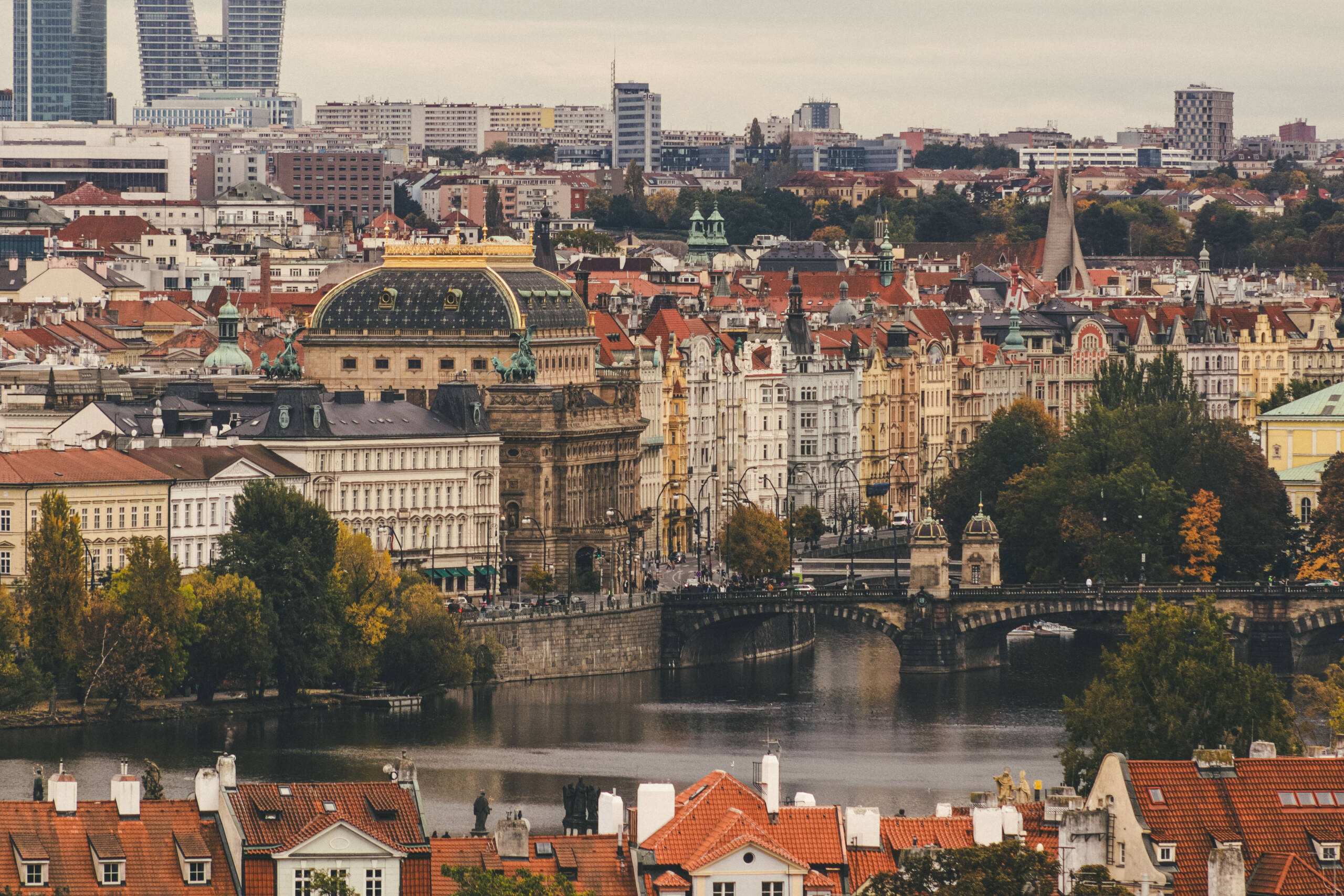There are certain places in Prague where the city lets you glimpse not just a scene but its whole personality, and this particular view across the Vltava is one of them. You don’t just see rooftops, water, and the proud dome of the National Theatre—you see Prague performing a story that doesn’t have a neat ending. It’s a city that insists on being many things at once, and if you stand high enough, if you look from just the right angle, all those identities collide in front of you like overlapping transparencies.

The rooftops in the foreground set the tone: warm red tiles, weathered chimneys, the kind of texture that reminds you life here is lived with windows that creak and attics that smell faintly of dust. It’s domestic, intimate, not staged for tourists. That layer is the baseline hum of the city, the background noise of ordinary Prague. But then your gaze lifts across the river, and suddenly the mood shifts. The Legion Bridge arcs across the water, heavy stone punctuated by decorative towers that look almost ceremonial, as if the city felt the need to announce, “Crossing here matters.” And on that bridge—though from this distance they’re tiny—are trams and cars and pedestrians. The trams are bright red streaks, bluntly practical and yet so woven into Prague’s image that they’ve become symbols of charm themselves. Pedestrians flow across with little awareness of how central they are to this composition.
And then, the anchor: the National Theatre. Its dome, edged with gold, rises like a crown, stubbornly theatrical, reminding everyone that art here isn’t just for decoration but for identity. The statues of the chariots stand at its corners like frozen movement, half myth and half civic pride. If you know the history, you remember this was a theatre literally rebuilt by the public when it burned, because a city like Prague cannot exist without its stage. Standing there, it almost seems less like a building and more like the city’s memory materialized in stone and copper.
But the real surprise of this angle is what lies beyond. Look past the gilded dome, and you hit the vertical insistence of apartment blocks and glass towers. They stand bluntly, without apology, puncturing the romance. In another city, you might resent their presence; here, they feel like the necessary reminder that the postcard is incomplete. Prague is not a museum, no matter how often visitors treat it like one. It’s a lived city, with people crammed into prefabricated blocks, with business towers reaching for relevance in a skyline that once only knew spires. The photograph doesn’t let you look away from that truth. It insists that modernity is here, whether you find it ugly or not.
The story this angle tells is layered. At the bottom, the intimacy of lived life. Across the river, the gesture of art and civic pride. In the distance, the blunt architecture of the present and the future. And weaving through it all, the bridge—a connector, a literal crossing, but also a metaphor for how Prague balances its identities. It doesn’t resolve them. It doesn’t have to. It just lets them exist side by side, like actors on a stage, each holding a role, each speaking at once.
There’s a temptation, of course, to romanticize Prague into a fairy tale, a place of endless red roofs and baroque facades. But when you stand at this angle, you realize the fairy tale isn’t the point. The point is that the city wears its contradictions openly. You can see the elegance of 19th-century architecture standing shoulder to shoulder with the stubborn mass of modern towers. You can see a theatre with mythological figures sharing a horizon with glass rectangles. It’s messy, but it’s true.
And maybe that’s why the angle matters. Photography teaches you that composition is not about capturing everything but about choosing what to include and what to omit. This view includes it all, refuses to omit, and in that honesty lies its beauty. It tells you Prague is not just the sum of its romantic facades but also the compromise of its post-war housing blocks, the ambition of its new towers, the continuity of its trams, and the persistence of its theatre. It’s a conversation in stone, metal, water, and time.
So when you stand here, you’re not just a spectator. You’re eavesdropping on that conversation, one that has been going on for centuries and will keep unfolding long after you’ve taken your photograph and moved on. The angle of the story is simply this: Prague doesn’t hide itself. It lets you see the whole script, contradictions and all.
Leave a Reply